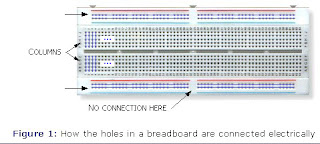You must be knowing a lot about circuit elements like resistors, diodes, capacitors,etc.
So in this post the intention is not to let you know about these elements.
I have depicted only few ideas but very important that you may need while making ckts.
BREADBOARD
Breadboard is used to make circuits. But mostly after testing your circuits on breadboard you will be making PCB.Breadboards costs from Rs.80-120(depends on place where you are in India).
All you require is to do a good wiring.Following figures show good wiring practices
Below you can see what connections you should NOT have to do.
However breadboards are not reliable. It is the PCB on which u have to make the circuit finally.
Some breadboards will be difficult to insert in IC's like 7805,LM317 etc due to the small sized holes.
some parts of the breadboard don't work after sóme days of use as the internal shorts in the breadboard get damaged. Always press the ICs gently into breadboard to avoid such damages rather than pressing them hard.
RESISTOR
resistors are used in digital circuits generally for voltage divider circuits,or in controlling the voltage across leds.
Resistances range from 10 ohm to 56Mohm(or more) and power ratings from 1/8W to 20W.These 1/8W resistors are used in low power devices. The one which available in shops are of 1/4W which we mainly use.
you can use a multi meter to measure resistance.
Generally you have to select a resistance from set of resistors and in that case it becomes difficult to measure the resistance of each to find the desired one. You should be accustomed to use colour coding of resistors.
Here is the 4 band colour code:
POTENTIOMETER ( ' POT ' )
These are resistors whose resistance can be varied. Potentiometers are available from 100 ohm to 470Kohm(or more).
Potentiometer is used as a voltage divider.If we connect Lead A to Vcc and Lead B to ground then you can get voltages from 0 to Vcc by taking voltage at LeadW and LeadB.
Given figures show different types of potentiometers available in market.
CAPACITORS:
A capacitor is used to store charge. Like resistors there is fixed as well as variable capacitor also.
There are capacitors with no polarity and polarity.
Ceramic and Mica capacitors available are of no-polarity, but electrolytic capacitors are of polarity.
Capacitance vary from 22pF to about 15000uF.
Values <.1uF are mainly mica and ceramic capacitors and C>=1uF are electrolytic capacitors.
We can identify negative lead of electrolytic capacitor by checking the length of the lead, one with less length is -ve.On the body of electrolytic capacitor -ve symbol is shown. Be careful about electrolytic capacitor because inverting polarity can make 'explosion' (not firing) of capacitor(sometimes it can hurt your body).
Every capacitor has two factors - value of its capacitance and other the maximum voltage rating.
So in this post the intention is not to let you know about these elements.
I have depicted only few ideas but very important that you may need while making ckts.
BREADBOARD
Breadboard is used to make circuits. But mostly after testing your circuits on breadboard you will be making PCB.Breadboards costs from Rs.80-120(depends on place where you are in India).
All you require is to do a good wiring.Following figures show good wiring practices
Below you can see what connections you should NOT have to do.
However breadboards are not reliable. It is the PCB on which u have to make the circuit finally.
Some breadboards will be difficult to insert in IC's like 7805,LM317 etc due to the small sized holes.
some parts of the breadboard don't work after sóme days of use as the internal shorts in the breadboard get damaged. Always press the ICs gently into breadboard to avoid such damages rather than pressing them hard.
RESISTOR
resistors are used in digital circuits generally for voltage divider circuits,or in controlling the voltage across leds.
Resistances range from 10 ohm to 56Mohm(or more) and power ratings from 1/8W to 20W.These 1/8W resistors are used in low power devices. The one which available in shops are of 1/4W which we mainly use.
you can use a multi meter to measure resistance.
Generally you have to select a resistance from set of resistors and in that case it becomes difficult to measure the resistance of each to find the desired one. You should be accustomed to use colour coding of resistors.
Here is the 4 band colour code:
POTENTIOMETER ( ' POT ' )
These are resistors whose resistance can be varied. Potentiometers are available from 100 ohm to 470Kohm(or more).
Potentiometer is used as a voltage divider.If we connect Lead A to Vcc and Lead B to ground then you can get voltages from 0 to Vcc by taking voltage at LeadW and LeadB.
Given figures show different types of potentiometers available in market.
CAPACITORS:
A capacitor is used to store charge. Like resistors there is fixed as well as variable capacitor also.
There are capacitors with no polarity and polarity.
Ceramic and Mica capacitors available are of no-polarity, but electrolytic capacitors are of polarity.
Capacitance vary from 22pF to about 15000uF.
Values <.1uF are mainly mica and ceramic capacitors and C>=1uF are electrolytic capacitors.
We can identify negative lead of electrolytic capacitor by checking the length of the lead, one with less length is -ve.On the body of electrolytic capacitor -ve symbol is shown. Be careful about electrolytic capacitor because inverting polarity can make 'explosion' (not firing) of capacitor(sometimes it can hurt your body).
Every capacitor has two factors - value of its capacitance and other the maximum voltage rating.











No comments:
Post a Comment